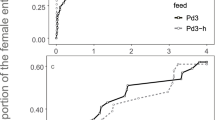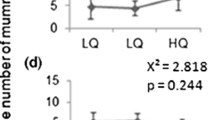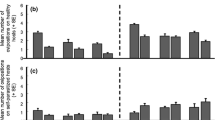Abstract
The present study aimed to address how an insect parasitoid makes patch-departure decisions from various types of host patches and how previous patch experiences in the environment modify this decision-making process. Experiments were done with the parasitic wasp Aphidius rhopalosiphi attacking the grain aphid Sitobion avenae. In the experiments, wasps were observed in a laboratory environment containing several patches of various host densities, and behavioural records were analysed using a Cox’s proportional hazards model. Consideration of the effect of the within-patch experience gave a classic pattern of patch-leaving decision rules in parasitoids: A. rhopalosiphi used local information on host quality (i.e. numbers of ovipositions or rejections) and availability (i.e. patch density) to determine departure decision. However, consideration of previous patch experiences provided evidence that these departure rules are fundamentally dynamic, responding to the physiological state of the animal and the information it has about its environment. Results showed that A. rhopalosiphi decreased its tendency to leave the visited patch after an oviposition. However, when a female has already laid several other eggs in the environment, such an incremental mechanism gradually switched to a decremental one. Hence, A. rhopalosiphi responded to egg-load depletion by leaving the visited patches sooner and by depositing a smaller number of eggs in those patches, which probably led to a decreased level of superparasitism. Results also indicated that previous experiences enabled wasps to estimate spatial host distribution and then to adjust their behavioural decisions accordingly. Thus, A. rhopalosiphi was shown to adjust its patch residence time according to the quality and the number of the patches previously visited. These proximate mechanistic rules adopted by A. rhopalosiphi females are discussed in the context of general predictions from optimality models.




Similar content being viewed by others
References
Alphen JJM van (1993) Patch residence time and encounters with parasitized hosts: a reaction. Neth J Zool 43:340–349
Alphen JJM van, Galis F (1983) Patch time allocation and parasitization efficiency of Asobara tabida, a larval parasitoid of Drosophila. J Anim Ecol 52:937–952
Alphen JJM van, Vet LEM (1986) An evolutionary approach to host finding and selection. In: Waage JK, Greathead D (eds) Insect parasitoids. Academic, London, pp 23–61
Alphen JJM van, Bernstein C, Driessen G (2003) Information acquisition and time allocation in insect parasitoids. Trends Ecol Evol 18:81–87
Bernstein C, Driessen G (1996) Patch-marking and optimal search patterns in the parasitoid Venturia canescens. J Anim Ecol 65:211–219
Bernstein C, Kacelnik A, Krebs JR (1988) Individual decisions and the distribution of predators in a patchy environment. J Anim Ecol 57:1007–1026
Bernstein C, Kacelnik A, Krebs JR (1991) Individual decisions and the distribution of predators in a patchy environment. II. The influence of travel costs and structure of the environment. J Anim Ecol 57:1007–1026
Bouchard Y, Cloutier C (1985) Role of olfaction in host finding by aphid parasitoid, Aphidius nigripes (Hymenoptera: Aphidiidae). J Chem Ecol 11:801–808
Budenberg WJ (1990) Honeydew as a contact kairomone for aphid parasitoids. Entomol Exp Appl 55:139–147
Charnov EL (1976) Optimal foraging: the marginal value theorem. Theor Popul Biol 9:129–136
Collett D (1994) Modelling survival data in medical research. Chapman and Hall, London
Cox DR (1972) Regression models and life tables. Biometrics 38:67–77
Dedryver C (1987) Biologie, écologie et dynamique de population des pucerons des céréales en climat océanique. PhD thesis, University of Paris XI
Driessen G, Bernstein C (1999) Patch departure mechanisms and optimal host exploitation in an insect parasitoid. J Anim Ecol 68:445–459
Driessen G, Bernstein C, Alphen JJM van, Kacelnik A (1995) A count-down mechanism for host search in the parasitoid Venturia canescens. J Anim Ecol 64:117–125
Fauchald P (1999) Foraging in a hierarchical patch system. Am Nat 153:603–613
Galis F, Alphen JJM van (1981) Patch time allocation and search intensity of Asobara tabida Nees (Braconidae), a larval parasitoid of Drosophila. Neth J Zool 31:596–611
Godfray HCJ (1994) Parasitoids. Behavioral and evolutionary ecology. Princeton University Press, Princeton
Godfray HCJ, Shimada M (1999) Parasitoids: a model system to answer questions in behavioral, evolutionary and population biology. Res Popul Ecol 41:3–10
Green RF (1980) Bayesian birds: a simple example of Oaten’s stochastic model of optimal foraging. Theor Popul Biol 18:244–256
Green RF (1984) Stopping rules for optimal foragers. Am Nat 123:30–40
Haccou P, De Vlas SJ, Alphen JJM van, Visser ME (1991) Information processing by foragers: effects of intra-patch experience on the leaving tendency of Leptopilina heterotoma. J Anim Ecol 60:93–106
Heimpel GE, Rosenheim JA (1998) Biol Control 11:160–168
Hemerik L, Driessen G, Haccou P (1993) Effects of intra-patch experiences on patch time, search time and searching efficiency of the parasitoid Leptopilina clavipes. J Anim Ecol 62:33–44
Houston A, Clark C, McNamara J, Mangel M (1988) Dynamic models in behavioral and evolutionary ecology. Nature 332:29–34
Iwasa Y, Higashi M, Yamamura N (1981) Prey distribution as a factor determining the choice of optimal foraging strategy. Am Nat 117:710–723
Iwasa Y, SuzukiY, Matsuda H (1984) The oviposition strategy of parasitoids. I. Effects of mortality and limited egg number. Theor Popul Biol 25:205–227
Kalbfleisch JD, Prentice RL (1980) The statistical analysis of failure time data. Wiley, New York
Krespi L (1990) Etude de la biocénose parasitaire des pucerons des céréales dans le bassin de Rennes: cas particulier d’Aphidius uzbekistanicus Luz. PhD thesis, University of Rennes I
Krespi L, Dedryver CA, Rabasse JM, Nénon JP (1994) A morphometric comparison of aphid mummies containing diapausing vs. non-diapausing larvae of Aphidius rhopalosiphi (Hymenoptera: Braconidae, Aphidiinae). Bull Entomol Res 84:45–50
Mangel M (1987) Oviposition site selection and clutch size in insects. J Math Biol 25:1–22
Mangel M (1989a) An evolutionary interpretation of the “motivation to oviposit”. J Evol Biol 2:157–172
Mangel M (1989b) Evolution of host selection in parasitoids: does the state of the parasitoid matter? Am Nat 133:688–705
Mangel M, Clark CW (1988) Dynamic modelling in behavioral ecology. Princeton University Press, Princeton
McNamara J, Houston A (1985) A simple model of information use in the exploitation of patchily distributed food. Anim Behav 33:553–560
Oaten A (1977) Optimal foraging in patches: a case for stochasticity. Theor Popul Biol 12:263–285
Outreman Y, Le Ralec A, Plantegenest M, Pierre JS (2001a) Superparasitism limitation in an aphid parasitoid: cornicle secretions avoidance and host discrimination. J Insect Physiol 47:339–348
Outreman Y, Le Ralec A, Wajnberg E, Pierre JS (2001b) Can imperfect host discrimination explain partial patch exploitation in parasitoids? Ecol Entomol 26:271–280
Powell W, Zhang ZL (1983) The reactions of two cereal aphids parasitoids, Aphidius uzbekistanicus and A. ervi to host aphids and their food-plants. Physiol Entomol 8:439–443
Roermund HJW van, Hemerik L, Lenteren JC van (1994) Influence of intrapatch experiences and temperature on the time allocation of the whitefly parasitoid Encarsia formosa (Hymenoptera: Aphelinidae). J Insect Behav 7:483–501
Rosenheim JA, Mangel M (1994) Patch-leaving rules for parasitoids with imperfect host discrimination. Ecol Entomol 19:374–380
Shirota Y, Carter N, Rabbinge R, Ankersmit GW (1983) Biology of Aphidius rhopalosiphi, a parasitoid of cereal aphids. Entomol Exp Appl 34:27–34
Sirot E, Bernstein C (1997) Food searching and superparasitism in solitary parasitoids. Acta Oecol 18:63–72
Steenis MJ van, El-Khawass KAMH, Hemerik L, Lenteren JC van (1996) Time allocation of the parasitoid Aphidius colemani (Hymenoptera: Aphidiidae) foraging for Aphis gossypii (Homoptera: Aphidae) on cucumber leaves. J Insect Behav 9:283–295
Stephens DW, Krebs JR (1986) Foraging theory. Princeton University Press, Princeton
Strand MR, Vinson SB (1982) Behavioral response of the parasitoid Cardiochiles nigriceps to a kairomone. Entomol Exp Appl 31:308–315
Vos M, Hemerik L, Vet LEM (1998) Patch exploitation by the parasitoids Cotesia rubecula and Cotesia glomerata in multi-patch environments with different host distributions. J Anim Ecol 67:774–783
Waage JK (1979) Foraging for patchily-distributed hosts by the parasitoid, Nemertis canescens. J Anim Ecol 48:353–371
Wajnberg E, Rosi MC, Colazza S (1999) Genetic variation in patch time allocation in a parasitic wasp. J Anim Ecol 68:121–133
Wajnberg E, Curty C, Colazza S (2004) Genetic variation in the mechanisms of direct mutual interference in a parasitic wasp: consequences in terms of patch-time allocation. J Anim Ecol 73:1179–1189
Winder L, Pery JN, Holland JM (1999) The spatial and temporal distribution of the grain aphid Sitobion avenae in winter wheat. Entomol Exp Appl 93:277–290
Acknowledgements
We are grateful to C. Bernstein and three anonymous referees for their useful comments and suggestions on an earlier draft of the manuscript. J. van Alphen, C.A. Dedryver, M. Hochberg and M. Plantegenest are acknowledged for stimulating discussions about this work. We thank also F. Lefèvre and B. Chaubet for their technical assistance. This study was supported by grants from the Ministère de l’Agriculture and from the Ministère de l’Education, de la Recherche et de la Technologie, France. All the experimental procedures conformed to French law.
Author information
Authors and Affiliations
Corresponding author
Additional information
Communicated by D. Gwynne
Rights and permissions
About this article
Cite this article
Outreman, Y., Le Ralec, A., Wajnberg, E. et al. Effects of within- and among-patch experiences on the patch-leaving decision rules in an insect parasitoid. Behav Ecol Sociobiol 58, 208–217 (2005). https://doi.org/10.1007/s00265-004-0895-1
Received:
Revised:
Accepted:
Published:
Issue Date:
DOI: https://doi.org/10.1007/s00265-004-0895-1




